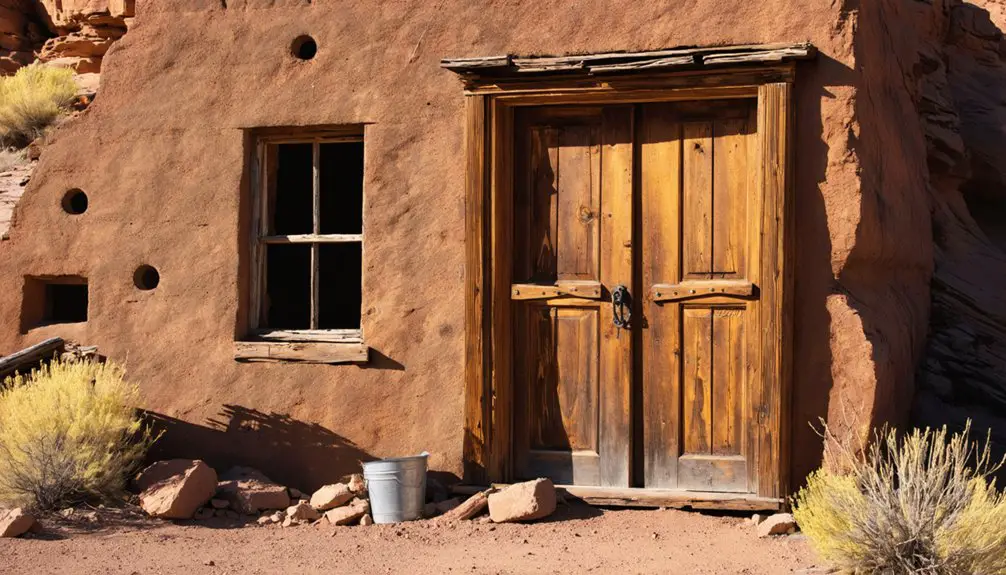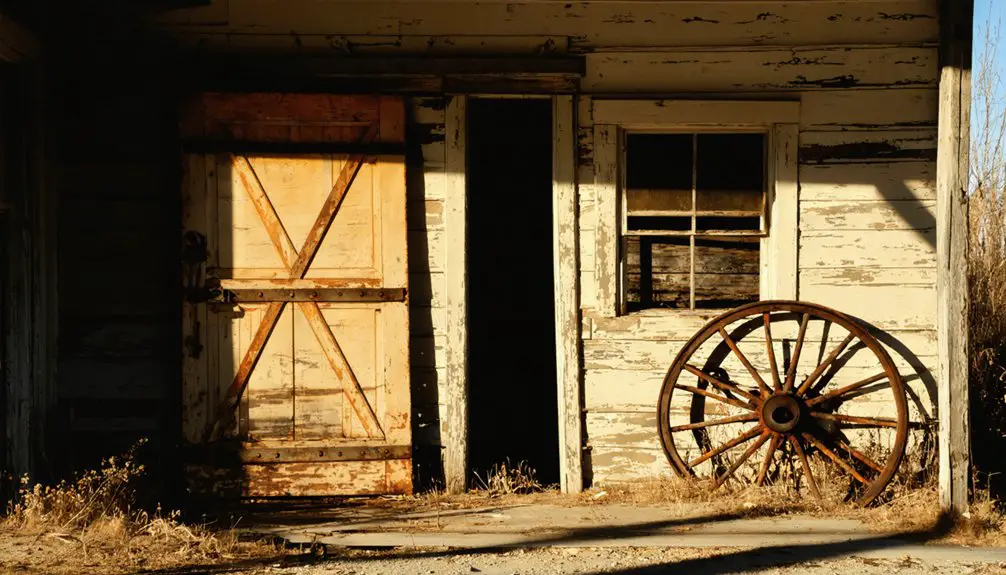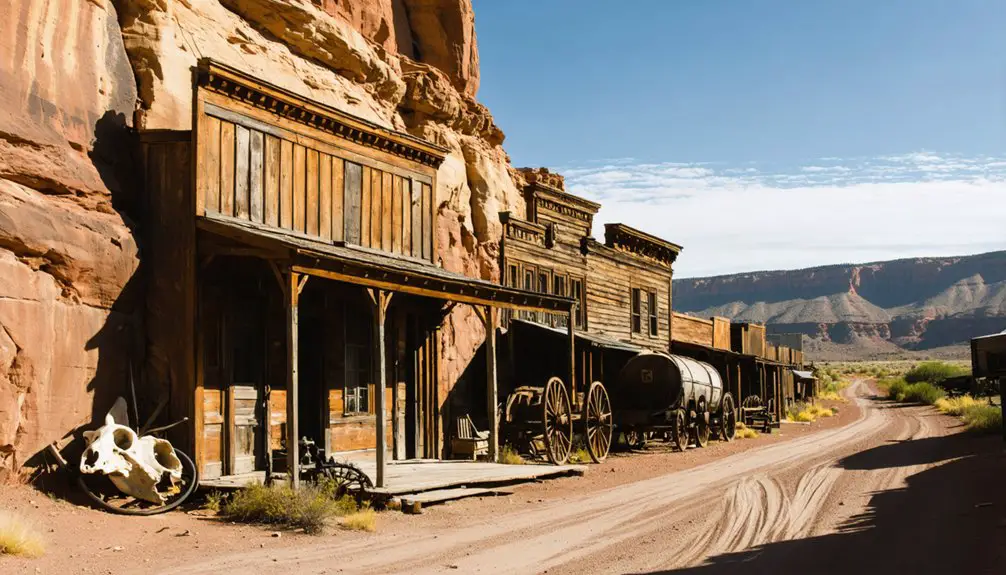You’ll find Cedar Creek ghost town in Box Elder County, Utah, where Mormon pioneers established an iron manufacturing settlement in 1851. The community, built in a defensive fort-style layout near Coal Creek, thrived with about twenty families until the 1920s. Agricultural challenges, harsh winters, and economic isolation ultimately led to its abandonment. Today, you can explore remnants of dilapidated wooden structures, stone foundations, and rusted machinery that tell a deeper pioneer story.
Key Takeaways
- Cedar Creek was established in 1851 as a Mormon settlement focused on iron manufacturing and agriculture near Little Muddy Creek.
- The fort-style community reached its peak in early 1900s with twenty families before declining due to harsh environmental conditions.
- Agricultural challenges, severe droughts, and limited economic opportunities led to the town’s complete abandonment by the 1920s.
- Remnants include dilapidated wooden structures, stone chimney foundations, and rusted machinery from the original sawmill.
- The Utah Ghost Town Project leads preservation efforts to protect the site’s remaining structures and artifacts.
A Brief Look at Cedar Creek’s Pioneer Roots
While early exploration parties identified Cedar Creek as a promising settlement site in 1849, the area’s true pioneer story began when John Chatterly and John Urie arrived in November 1851.
Cedar Creek’s destiny as a settlement was first glimpsed in 1849, but its true pioneers arrived two years later.
Their pioneer motivations centered on establishing an iron manufacturing hub to reduce dependency on costly imports, aligning with Brigham Young’s vision for Mormon self-sufficiency. The settlement became part of the north-south line of communities stretching from Cache Valley to Utah’s Dixie. Settlers faced ongoing challenges balancing farm work with their iron production efforts.
You’ll find their settlement strategies were carefully planned. They built a fort-like arrangement of houses near Little Muddy Creek, which they later renamed Coal Creek after discovering valuable coal deposits.
The location, eight miles from iron-rich mountains and two miles from the creek mouth, proved strategic for the Iron Mission‘s goals. The settlers’ determination was evident as they transformed wagon tires into machinery parts and leveraged the abundant cedar wood for fuel.
Life in Early Cedar Creek Settlement
As settlers established Fort Cedar in the early 1850s, they constructed a carefully planned community of cottonwood log houses arranged in a fort-style layout at the western base of a hill.
You’d find their half-mile square settlement enclosed by protective walls, with carefully positioned homes and gardens designed to avoid flooding risks.
Community cooperation defined daily life, as militia-organized groups worked together on essential tasks like plowing fields, cutting timber, and building fortifications. Under the leadership of Henry Lunt’s militias, the settlers maintained organization and defense of the growing settlement.
They’d create an intricate network of barns, sheds, and farming plots while developing crucial road systems. The settlement benefited from abundant iron ore deposits discovered nearby, which supported the region’s early industrial development.
Indigenous interaction initially proved beneficial, with Southern Paiute peoples helping settlers with agriculture and sharing knowledge of local plants.
However, these relationships soon deteriorated as competition for resources intensified, particularly due to settlers’ livestock impacting traditional Paiute food sources.
Agricultural Heritage and Farming Practices
During the early settlement period, Cedar Creek’s agricultural practices reflected a careful balance between innovation and conservation.
You’ll find that settlers embraced crop diversity, planting various crops suited to the region’s challenging 135-day frost-free growing season. They didn’t pursue risky monoculture farming, instead focusing on self-sustaining production that kept them debt-free. The emphasis on community over profit guided their farming decisions, following the broader Utah territory’s agricultural philosophy.
The community’s irrigation techniques drew from Mormon pioneers’ expertise, who’d built extensive canal systems throughout Utah. Cedar Creek farmers diverted mountain streams through communal irrigation systems, carefully managing water resources in their arid environment. Within two decades of initial settlement, the region saw over 1000 miles of irrigation canals constructed.
This approach proved essential, as agriculture consumed over 70% of the Great Salt Lake Basin’s water. Despite their resourcefulness with dry farming methods and water management, environmental stresses eventually overwhelmed the settlement, leading to its abandonment.
The Community’s Peak Years
Once Cedar Creek reached its zenith in the early 20th century, you’d find about twenty families living in this tight-knit farming community.
To avoid confusion with other Cedar Creek locations, proper documentation of this Utah ghost town’s history became essential.
The local schoolhouse served as the heart of daily life, doubling as a church and vibrant social center where community events brought everyone together. You could attend dances, watch theater performances, or enjoy talent shows with your neighbors. Like the nearby Cosmopolitan Restaurant remnants, these gathering spaces held special meaning for residents.
The town hummed with activity, supported by essential businesses like the general store and an inn for travelers.
Mail delivery came right to your door rather than a central post office, highlighting the intimate nature of Cedar Creek life.
Social gatherings often centered around the schoolteacher, whose wisdom guided both educational and agricultural matters in this flourishing rural settlement.
Economic Challenges and Rural Hardships
Despite Cedar Creek’s earlier prosperity, harsh environmental conditions in the 1920s dealt severe blows to the community’s agricultural foundation.
You’ll find that prolonged droughts and severe winters crippled crop yields, while the lack of irrigation infrastructure made farming increasingly unsustainable.
The town’s economic significance suffered from its limited commercial base – just a store, inn, and school – while isolation from major transportation routes restricted market access for local farmers.
Much like the challenges that led to Iron City’s abandonment in 1876, agricultural sustainability became nearly impossible as younger generations left for better opportunities elsewhere. The small population of roughly 20 families couldn’t maintain the critical mass needed for economic growth, and the absence of diversification beyond farming left Cedar Creek vulnerable.
Unlike nearby areas that benefited from mining, Cedar Creek’s singular reliance on agriculture proved insufficient for long-term survival. The rich iron deposits that supported Frontier Homestead settlers elsewhere in the region were notably absent here.
The Path to Abandonment
As harsh weather patterns intensified throughout the 1920s, Cedar Creek’s path to abandonment accelerated through a combination of environmental and social pressures.
You’ll find that consecutive dry summers and brutal winters devastated crop yields, undermining the farming foundation that had sustained the community since the 1860s.
While the new interstate highway system might’ve sparked growth elsewhere, it instead made it easier for Cedar Creek’s residents to seek opportunities in more prosperous areas.
The interstate bypassed Cedar Creek entirely, transforming what could have been a lifeline into an exodus route for desperate residents.
Weather impacts proved relentless, and transportation changes offered an escape route rather than salvation.
The town’s social fabric began unraveling as families departed, leaving behind their cultural gatherings and communal activities.
What Remains Today

As you explore Cedar Creek’s remnants today, you’ll find several dilapidated wooden structures and stone chimney foundations scattered across the forested landscape.
The site contains rusted machinery from the original sawmill, collapsed mine entrances with deteriorating support beams, and fragments of old fencing that once marked property boundaries.
Archaeological evidence includes scattered mining tools, broken glass and ceramics, and personal artifacts that offer glimpses into the daily lives of former residents.
Limited Physical Structures Visible
Time has left only sparse remnants of Cedar Creek‘s once-vibrant community, with just a handful of deteriorating structures still visible today.
You’ll find an adobe schoolhouse that stands as the best-preserved building, having served as the town’s educational, religious, and social hub. A partially intact stone house reveals glimpses of pioneer life through its remaining fireplace, timber floors, and plastered walls.
While ghost town preservation efforts remain minimal, structural deterioration continues to claim what’s left of Cedar Creek’s commercial buildings.
You’ll see only fragments of the original inn, store, and service station, mostly reduced to foundations and scattered stones. The site’s fragility has led to restricted access, as authorities work to protect these precious few remnants from further collapse or vandalism.
Archaeological Evidence and Ruins
Despite the limited standing structures, extensive archaeological evidence reveals Cedar Creek’s rich industrial heritage through careful excavation and study.
You’ll find remnants of stone-built houses with distinctive fireplaces and plastered interior walls, suggesting a level of refined pioneer living. The settlement layout indicates a thoughtfully planned community, with archaeological artifacts pointing to the presence of a schoolhouse, post office, and boarding house during its peak around 1871.
The site’s most significant industrial features include two surviving charcoal ovens and evidence of iron production facilities that once produced up to seven tons daily.
Archaeological artifacts include blacksmithing equipment and ore processing remnants, painting a picture of a bustling industrial settlement.
Today, careful preservation efforts protect these fragile ruins while allowing continued research into Cedar Creek’s pioneer past.
Historical Significance in Box Elder County
Cedar Creek’s rise and fall exemplifies the challenges early Box Elder County pioneers faced when establishing agricultural settlements in Utah’s harsh environment.
You’ll find Cedar Creek’s story mirrors other regional settlement attempts of the 1860s, where farmers sought to cultivate challenging terrain with limited resources and infrastructure.
The town’s eventual abandonment by the 1920s, driven by severe weather conditions and crop failures, represents a broader pattern of rural depopulation that reshaped Box Elder County’s agricultural landscape in the early 20th century.
Pioneer Settlement Patterns
As Brigham Young strategically directed Mormon settlement patterns in the 1850s, Box Elder County’s pioneer communities emerged through careful organization and planning.
Pioneer motivations centered on creating self-sufficient settlements while establishing religious and economic strongholds in the region.
The settlement strategies followed three key principles:
- Establishing defensive fort-style arrangements with log houses to protect against external threats
- Positioning communities near essential natural resources, including water sources and fuel materials
- Creating logistical nodes that supported travel and trade routes between major settlements
You’ll find that these early settlements reflected a sophisticated understanding of resource management, with communities deliberately placed to access multiple natural materials while avoiding hazardous areas like floodplains.
The pioneers’ organizational structure, combining military discipline with religious governance, helped guarantee these settlements’ survival.
Rural Development Challenges
Throughout the early 20th century, Box Elder County’s rural communities faced mounting development challenges that would ultimately doom settlements like Cedar Creek to abandonment.
The town’s basic rural infrastructure – consisting of just a multi-purpose school, inn, and grocery store – proved insufficient to sustain long-term growth. Cedar Creek’s agricultural dependency left it vulnerable to devastating environmental pressures, including persistent droughts and harsh winters that plagued the 1920s.
Without railroads or major transportation hubs, farmers struggled to reach broader markets, while limited natural resources prevented economic diversification. The small community of roughly 20 families relied heavily on informal social networks centered around the schoolhouse, but these bonds couldn’t overcome the harsh realities of failing crops and deteriorating soil conditions.
Preserving Cedar Creek’s Legacy

Preserving the legacy of this Box Elder County settlement presents unique challenges and opportunities for Utah’s historical conservation efforts. Community engagement and preservation strategies are essential for protecting Cedar Creek’s remaining structures while sharing its pioneer story with future generations.
The Utah Ghost Town Project leads preservation initiatives through:
The Utah Ghost Town Project spearheads vital preservation work to protect and document our state’s vanishing historical settlements.
- Documentation and photography of surviving buildings
- Collaboration with local historical groups
- Public education through online resources and guided tours
You’ll find Cedar Creek’s preservation efforts are complicated by harsh weather conditions and limited surviving structures.
However, by connecting with nearby ghost towns’ successful conservation models and participating in regional heritage events, you can help maintain this important piece of Utah’s rural farming history for years to come.
Frequently Asked Questions
Were Any Native American Artifacts Discovered Near Cedar Creek’s Settlement Area?
You’ll find abundant Native artifacts throughout Cedar Creek’s settlement area, including Fremont projectile points, ceramic pieces, grinding stones, and pictographs – all holding tremendous historical significance to Utah’s indigenous cultures.
What Were the Most Common Livestock Breeds Raised by Cedar Creek Farmers?
You’d find dairy cows and beef cattle were primary livestock, alongside substantial sheep herds. While specific breeds aren’t documented, the region’s livestock diversity shaped local farming practices through seasonal grazing.
Did Cedar Creek Have Its Own Schoolhouse or Church Building?
You’ll find Cedar Creek had one main building that served both purposes – the schoolhouse hosted church services and education, making it the heart of community life until the town’s 1920s abandonment.
What Was the Primary Water Source Used for Irrigation?
You’ll find that surface water from perennial streams, especially Coal Creek, provided the main irrigation source. Early water management relied on earth-dug channels, while irrigation techniques expanded to include groundwater pumping later.
Were There Any Documented Marriages Between Cedar Creek Families and Neighboring Settlements?
Like scattered seeds seeking fertile ground, you’ll find no definitively documented Cedar Creek marriages with neighboring settlements in available records, though such unions likely occurred given the region’s close-knit rural community patterns.
References
- https://www.valleyjournals.com/2024/10/02/507818/exploring-utah-s-ghost-towns-seven-abandoned-settlements-with-fascinating-histories
- https://www.utahlifemag.com/blog/post/4-ghost-towns
- https://www.youtube.com/watch?v=eLGiwso6oZI
- https://www.familysearch.org/en/wiki/Cedar_Creek
- https://www.visitutah.com/things-to-do/history-culture/ghost-towns
- https://utahrails.net/mining/dup-mining.php
- https://www.uen.org/utah_history_encyclopedia/c/COLONIZATION_OF_UTAH.shtml
- https://en.wikipedia.org/wiki/Mormon_pioneers
- https://archives.utah.gov/2021/04/01/utahs-road-to-statehood-latter-day-saint-pioneers/
- https://graftonheritage.org/history-settlement/



